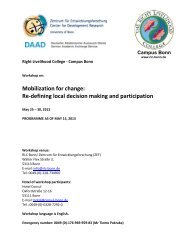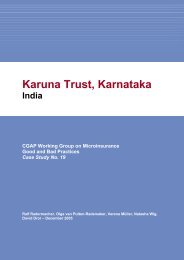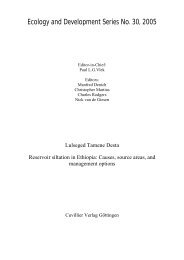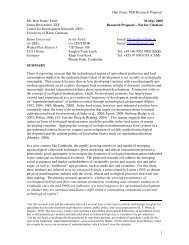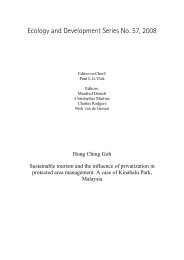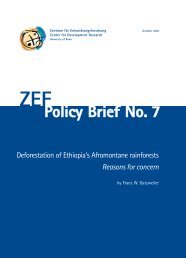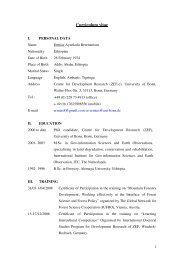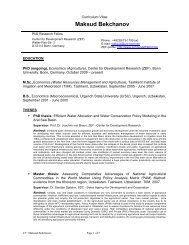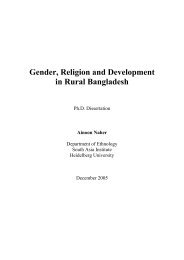Ecology and Development Series No. 10, 2003 - ZEF
Ecology and Development Series No. 10, 2003 - ZEF
Ecology and Development Series No. 10, 2003 - ZEF
- No tags were found...
You also want an ePaper? Increase the reach of your titles
YUMPU automatically turns print PDFs into web optimized ePapers that Google loves.
Current state of knowledgeMadagascar. However, the single tetraploid species of the genus, C. arabica, isgeographically disjunct from all other coffee species <strong>and</strong> is confined to the Ethiopianhighl<strong>and</strong> plateau. There are two records of occurrence of C. arabica in forests outsideEthiopia: Mount Marsabit in northern Kenya <strong>and</strong> Mount Boma in southeast Sudan (Friis1979). However, these areas <strong>and</strong> the respective coffee populations have not beensufficiently investigated to confirm whether these are natural populations or escapes fromcultivation. A recent study using RAPD markers shows that the population on MountMarsabit is more similar to a widely grown cultivar of the species in plantations of Kenyathan to the wild population, <strong>and</strong> its truly wild origin is questionable (Lashermes et al.1996).The wild populations of C. arabica occur in the humid forests of southwest <strong>and</strong>southeast Ethiopia, separated from each other by the Great Rift Valley (GRV), at altitudesranging between <strong>10</strong>00 <strong>and</strong> 2000 m. The southwestern forests constitute the main ecoregionof the species. Specifically, it occurs in the Illubabor, Jimma, West Wellega <strong>and</strong> Bale zonesof Oromia State, <strong>and</strong> in the Kaffa, Sheka, Bench <strong>and</strong> Maji zones of the Southern Nations<strong>and</strong> Nationalities People (SNNP) state. Localities known for their high abundance of coffeetrees, <strong>and</strong> hence important for conservation <strong>and</strong> sustainable use of wild populations of thespecies are the Amora-Gedel, Berhane-Kontir, Boginda-Yeba, Dawo-Tobi, Geba-Dogi(Yayu), Harenna (Bale mountains), Maji, <strong>and</strong> Mankera forests. All are on the southwesternplateau except the Harenna forest, which is located east of the GRV. In its natural range,coffee is one of the dominant plant species in the shrub or small tree layer.2.4 Approaches in plant genetic conservationApproaches in plant genetic conservation can be broadly categorized into two: Ex situ <strong>and</strong>in situ. In situ conservation is defined in Article 2 of the Convention on BiologicalDiversity (CBD) as the conservation of ecosystems <strong>and</strong> natural habitats & the maintenance<strong>and</strong> recovery of viable populations of species in their natural surroundings <strong>and</strong>, in the caseof domesticated or cultivated species, in the surroundings where they have developed theirdistinctive properties (UNCED 1992). This is a broad definition <strong>and</strong> recognizes theconservation of plants in both their natural habitats <strong>and</strong> man-made habitats like farms <strong>and</strong>20



